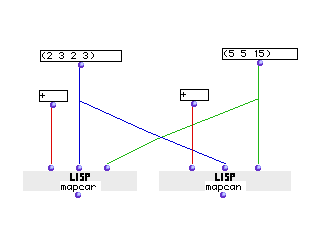OpenMusic Reference
mapcan

mapcan
(LISP function) -- returns the results of several evaluations of function as a single entity
Syntax
mapcan function list &restmore-lists
Inputs
| name | data type(s) | comments |
|---|---|---|
| function | symbol, function name or lambda function | the function that will be evaulated |
| list | a list or tree | A list of arguments for the first input of function |
| more-lists | a list or tree | repeatable; lists of arguments for additional inputs of function |
Output
| output | data type(s) | comments |
|---|---|---|
| first | any | the results of the evaluations |
Description
Calls function , passing it the first argument of list and more- lists , then calling it again, but passing the second element of list and more-lists , and so on, until the lists (or the shortest of the input lists, if they are not the same length) has been exhausted. The results of the series of function calls are combined with the function nconc and returned as a list.
function may be a symbol, a function name, or function in lambda mode. Note that if you pass a function in lambda mode with repeatable inputs, you must add the correct number to accomodate the number of arguments you are passing it at the other inputs. This is not necessary if the function name is entered directly instead of its icon in lambda mode.
mapcan is similar in operation to funcall , which also calls function but only calls it once, passing all its arguments simultaneously. mapcan is also similar to mapcar , which iterates lists as arguments to function in the same way but returns the results as separate sublists. See examples.

| LISP functions |
|---|
| The basic LISP functions are too numerous to document comprehensively in this manual. As an aid to the neophyte, the most commonly used have been included in this documentation, but they represent a small fraction of the total functionality of the MCL environment. Numerous on-line resources exist, for instance the online version of Common Lisp the Language, 2nd Edition. |
Examples
Comparing mapcan and mapcar

This illustrates the difference between mapcan and mapcar . They will both get the same inputs, the function list and the lists (2 3 2 3) and (5 5 15). Both will pass the first elements of the two lists to list , then the second, then the third. Notice that the first list has four elements. This fourth element is not used by either, since the smaller of the two lists only has three elements and the rule of the shortest list is observed.
mapcar returns the results of each list operation as sublists within a larger list:
? OM->((2 5) (3 5) (2 15))
while mapcan , performs nconc on its results. nconc is a LISP function which appends lists. So the subgroups are removed from the mapcan output:
? OM->(2 5 3 5 2 15)
Because nconc is a destructive function (meaning it alters the original, not making a copy) designed to append lists, if you use functions with mapcan that do not return lists as their output, the first elements of the results will actually be suppressed and only the final result will be returned. Try replacing the list function with the LISP function + :

Running mapcar now produces a list of the sums of the pairs of first, second, and third elements. These sums are not themselves lists:
? OM->(7 8 17)
Because of this, while mapcan , performs the nconc on the results, all but the last result are supressed. It returns:
? OM->17
| Prev | Home | Next |
|---|---|---|
| mat-trans | Up | mapcar |